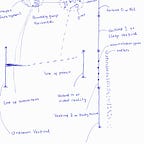Sentience: How Does the Brain Generate the Mind?
Conceptually, there is a structure of the human mind. There are components that makeup that structure. They have functions. The mind is the port of labels: thoughts, feelings, emotions, memory and reactions, but they are not the components of mind — necessary for its functions.
There are several mind activities that can be induced or inhibited through the brain, but the brain is not the mind.
The mind and brain are neighbors within the cranium, but are different. The brain is biological. It remains in the immediate aftermath of death, but the mind — not similarly material — is gone.
There are effects of brain health on the mind, as well as aging and conditions, but the components of the mind make the decision for all experiences.
What parts of the brain carry the mind? Where are their intersections? Is the mind superior to the brain?
It is known that sensory inputs converge at multiple hubs in the brain, prominently the thalamus. For smell, it is at the olfactory bulb. For internal senses, it is mostly the brainstem.
It is at these centers that senses are integrated, or say converted to something that can be useful, away from their differentiated forms. This conversion or integration, can be defined as the entry into the mind.
Simply, every sensation, internal or external, gets integrated in the brain. The purpose of the integration is for uniformity into the mind or into what the mind can accept. All sight, smell, touch, taste, sound and internal senses, go through this process.
Cells and molecules present at these sensory relay hubs in the brain do the integration. Then the newly integrated package can go on to join mind processes, or for interpretation, in other areas of the brain, mostly the cerebral cortex.
The commonality of electrical and chemical messages of nerve cells result in a group.
It is this collection that becomes what is known as the mind.
The capabilities of nerve cells extend beyond their ability to bear information, but to align their impulses into an intricate group.
There are different parts of the brain involved in some of the same experiences, to the group [or mind], they are destinations where degrees are obtained.
The group shapes impulses for knowing and experiences. This group as an outcome is beyond material that generated it. This makes the mind responsible for experiences with the world — not the chemical or electrical impulses, directly.
Simply, the group is adapted to knowing or to making experiences, breaking out from the brain and its general biology similar to other parts of the body. It makes these experiences [with the world] by the interaction of its components — quantities and properties.
Electrical impulses of nerve cells, as a collective, can be said to be quantities, while chemical impulses, as a group, can be said to be properties. The features of the components within the group is different from their individual ones.
It is also within the mind that decisions are finalized, not just by a neurotransmitter. For example, stress reaction is given off the group, not just because of norepinephrine. There could be some stressful situations with lots of calm, showing that the group overrides a neurotransmitter’s default.
It is the group that makes emotion, memory, reactions and feelings possible.
Conceptually, the mind is not as diverse as the brain, with tissues, blood vessels, cells and so forth. The mind has two major components, fusing with each other. These components have their features. They power every experience including the common labels of the brain.
Serotonin is never experienced, but mood is experienced and known.
Mood is a property or apparatus on the mind, like delight, sadness, thirst, anger, heat, cold, interest, dislike, cravings, prompting and so forth. Properties also include all memory, feelings, emotions, actions and reactions. The locations of properties may determine what they become as an experience, say an emotion or a feeling.
Consciousness is the interaction of the components of mind. Their outputs give experiences to the individual but the mechanisms are interactions.
The components of mind are quantities and properties. They are in a different form from molecules or cells, but are driven biologically by those. It is these quantities and properties — or apparatus qnd their interactions that underline being.
The cells and molecules of the brain have the mind as a collective uniformity, identity or unit, for knowing outcomes. The mind helps to know. To do so it has to hold information. To hold more information, it uses a form that is not directly biological that may need large changes in size. The quantities and properties of the mind have their mechanisms but are more democratic than the parts of the brain. They hold and spread multiple types of knowing — emotions, feelings, memory, reactions, in ways that are not localized within mind, but made available in other parts of the body.
The mind is a form where different parts of the brain make contributions. Regulation, modulation or control of internal senses are knowing processes, given by the mind, for functions across the body.
Some of the components of mind do so for body systems, linking the mind and the body. The mechanisms of the components of mind, in their steady and continuous states, sometimes set things up exceeding intentionality or free will.
